This post may contain affiliate links, and we may receive commission if you purchase any of the products listed below.
As we explore the evolving landscape of electronic pianos, we can’t help but notice the remarkable advancements in the 2025 models. These pianos offer incredible touch-sensitive keys, superior sound, and connectivity options that cater to musicians at every level. From budget-friendly choices to professional-grade instruments, there’s something for everyone. Let’s take a closer look at these top picks and discover which might be the perfect fit for your musical journey.
Donner OURA S100 Digital Piano with 88 Key Weighted Keyboard
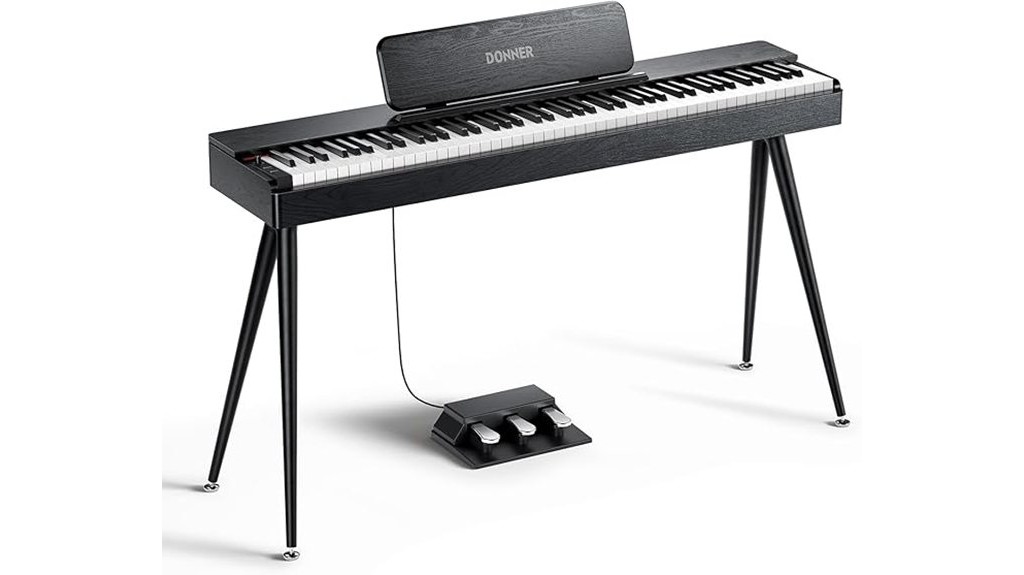
If you’re on the hunt for a digital piano that’s perfect for beginners and casual players, the Donner OURA S100 Digital Piano should be at the top of your list. With its 88 Key Graded Hammer Weighted Keyboard, you’ll experience the authentic feel of an acoustic piano. Bluetooth connectivity allows seamless integration with MIDI and audio apps. Its compact Scandinavian design suits any decor, while the built-in speakers deliver clear sound. You can easily assemble it in under 30 minutes. At approximately $300, it’s a great value for those enthusiastic to learn and practice without the need for professional studio quality.
Best For: Beginners and casual players looking for a compact, affordable digital piano with authentic acoustic feel and Bluetooth connectivity.
Pros:
- 88 Key Graded Hammer Weighted Keyboard simulates an acoustic piano touch.
- Bluetooth connectivity supports seamless integration with MIDI and audio apps.
- Compact design and easy assembly make it suitable for limited spaces.
Cons:
- Sound quality may not match higher-end digital pianos.
- Sustain pedal may feel too light for some users.
- Not recommended for professional studio use due to construction differences.
GLARRY Digital Piano 88-Key Weighted Hammer Action (White)
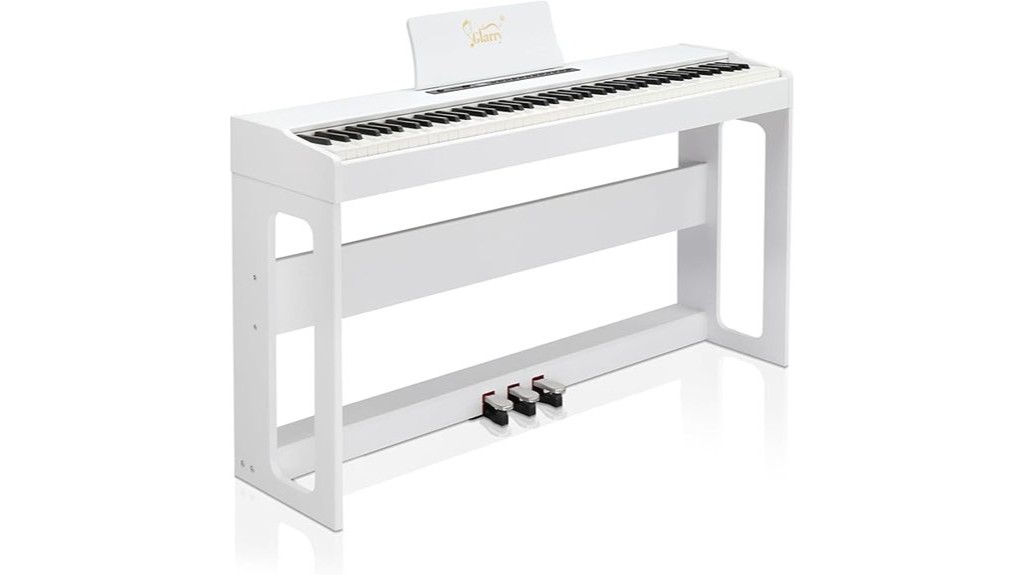
The GLARRY Digital Piano 88-Key Weighted Hammer Action (White) is an ideal choice for aspiring musicians and seasoned players alike, thanks to its full-weighted hammer action keyboard that closely mimics the touch of a traditional grand piano. You’ll appreciate the French DREAM sound source and two 10W stereo speakers that deliver rich tones. With dimensions of 49.6 x 12.6 x 27.9 inches, it fits comfortably in most spaces. The piano includes a power adapter, triple pedals, and more, making setup easy. While it’s great for beginners, advanced players might find it less durable. It ranks well and offers competitive pricing.
Best For: Aspiring musicians and beginners who want a budget-friendly digital piano with a realistic touch and sound.
Pros:
- Full-weighted hammer action keyboard emulates a traditional grand piano feel.
- Includes a variety of components such as triple pedals, headphones, and USB cable for easy setup.
- Offers dual Bluetooth connectivity for audio and MIDI.
Cons:
- Some experienced players find it lacking compared to high-end pianos.
- Concerns about durability for advanced use.
- Limited to 10W stereo speakers, which may not satisfy all users’ sound expectations.
Hamzer 61 Key Keyboard Piano Set for Beginners
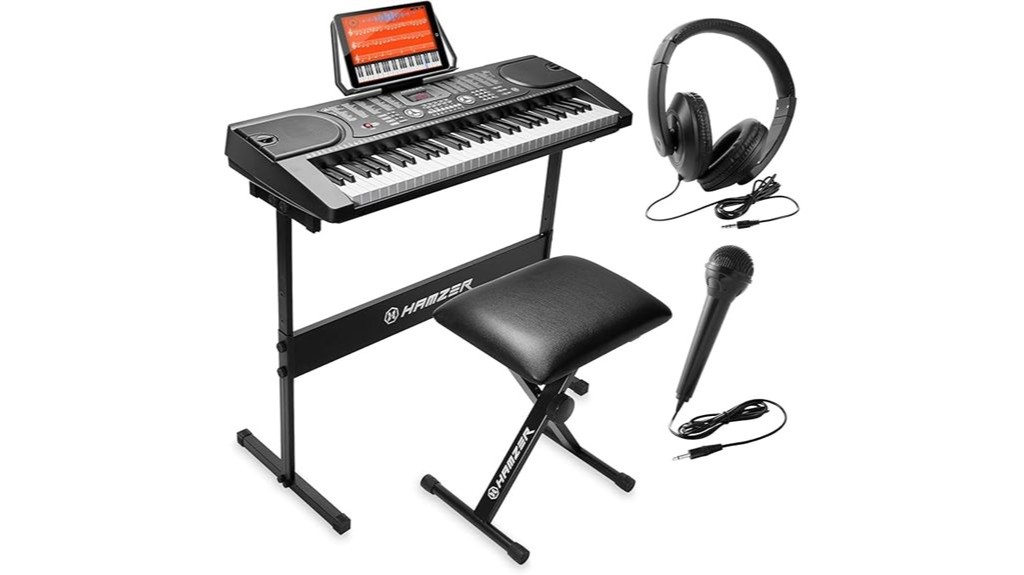
Beginners and intermediate players will find the Hamzer 61 Key Keyboard Piano Set an ideal choice when exploring electronic pianos in 2025. You’ll enjoy its authentic sound with built-in speakers, 255 timbres, and 24 demo songs. The 61 keys mimic a traditional feel, and transparent stickers help you master the layout. Explore effects like vibrato and sustain while recording your performances for playback. It easily adapts to your setup needs with its lightweight design, adjustable stand, and dual power options. Whether you’re practicing with headphones or sharing through stereo outputs, this keyboard supports your musical journey effortlessly.
Best For: Beginners and intermediate players seeking an electronic piano with authentic sound and versatile features in 2025.
Pros:
- Authentic sound quality with built-in speakers, 255 timbres, and 24 demo songs.
- Lightweight design and adjustable stand for easy setup and portability.
- Includes recording and playback functionality for practice improvement.
Cons:
- Requires 6 AA batteries which are not included.
- Limited to 61 keys, which may not suffice for advanced players.
- Transparent key stickers might wear out over time with frequent use.
YAMAHA P71 88-Key Digital Piano with Sustain Pedal
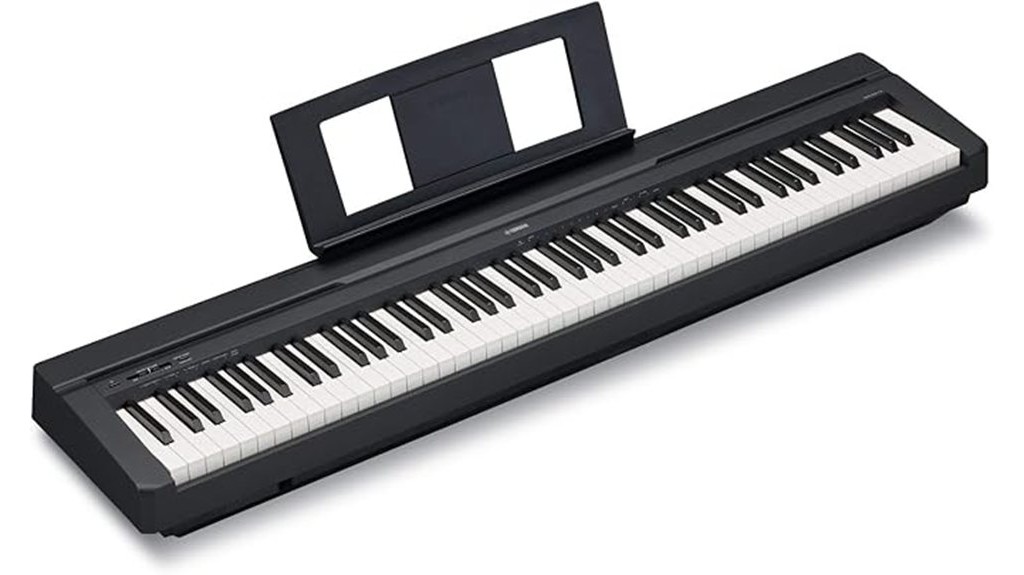
Explore the Yamaha P71 88-Key Digital Piano, a top choice for music enthusiasts seeking a high-quality yet affordable digital piano for home use. This piano features touch-sensitive, weighted keys that mimic an acoustic piano, offering you a dynamic playing experience. With 10 unique voices, including Yamaha’s grand piano, you’ll enjoy rich, full sound and deep bass. Dual Mode lets you layer voices, like piano and strings, for a fuller sound. It’s got simple one-button operation, a sustain pedal, and connectivity options like USB and headphone jacks. Weighing just 25 pounds, it’s portable and perfect for gigs or home practice.
Best For: Music enthusiasts and beginners seeking an affordable digital piano with realistic key action and portability.
Pros:
- Weighted, touch-sensitive keys provide an authentic acoustic piano feel.
- Offers 10 unique voices with rich sound quality and deep bass.
- Portable at 25 pounds, ideal for both home use and traveling to gigs.
Cons:
- Basic sustain pedal may slide during use.
- Limited to 10 voices, which might not satisfy advanced users.
- Simple design may lack advanced features found in higher-end models.
88 Key Semi Weighted Digital Piano for Beginners
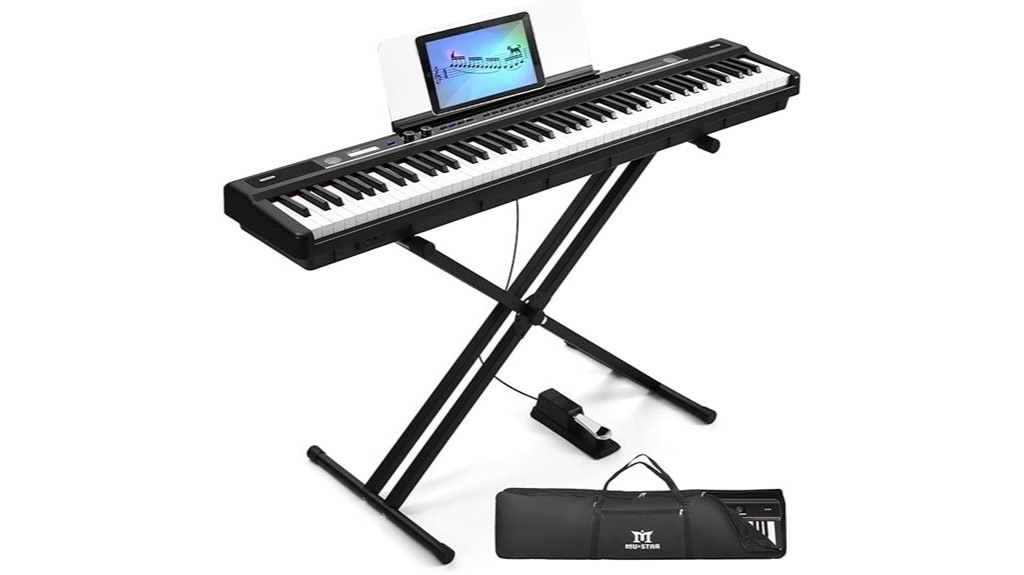
If you’re a beginner looking for an ideal digital piano, consider the 88 Key Semi Weighted Digital Piano. This full-size instrument offers a compact design with an elegant woodgrain finish, making it a stylish addition to any home. Its enhanced learning tools, like dual keyboards, are perfect for split-hand exercises, benefiting both students and instructors. You’ll enjoy expressive performances with its touch-sensitive keys and three pedals replicating grand piano functions. Explore creative possibilities with 800 tones, 600 rhythms, and advanced connectivity options like Bluetooth MIDI/audio. Dual headphone jacks and full recording capabilities guarantee a seamless and enriching musical experience.
Best For: Beginners looking for a stylish, full-size digital piano with enhanced learning tools and sound options.
Pros:
- Compact design with an elegant woodgrain finish.
- Dual keyboards for flexible learning and interactive practice.
- Extensive sound options with 800 tones and 600 rhythms.
Cons:
- May be overwhelming for absolute beginners due to the wide range of features.
- Limited portability due to its full-size design.
- Requires some setup for full utilization of connectivity features.
Donner 61 Key Keyboard Piano Kit for Beginners (DEK-610S)

The Donner 61 Key Keyboard Piano Kit for Beginners (DEK-610S) stands out as an excellent choice for aspiring musicians looking to kickstart their journey into music. With 249 voices and rhythms, this kit’s diverse sound options will keep your practice sessions engaging. It includes essentials like a stand, bench, and power adapter, making setup a breeze. The built-in 10W speakers deliver impressive sound, and the record feature allows you to capture your performances. While the keys aren’t pressure sensitive, the keyboard’s portability and beginner-friendly design make it ideal for home practice. You’ll appreciate its value and versatility.
Best For: Aspiring musicians and beginners looking for a budget-friendly and versatile keyboard for home practice.
Pros:
- Lightweight and portable
- Variety of voices and rhythms
- User-friendly for beginners
Cons:
- Keys not pressure sensitive or weighted
- Stand described as flimsy
- Microphone quality poor
61 Key Portable Electronic Keyboard Piano with Lighted Keys & Accessories
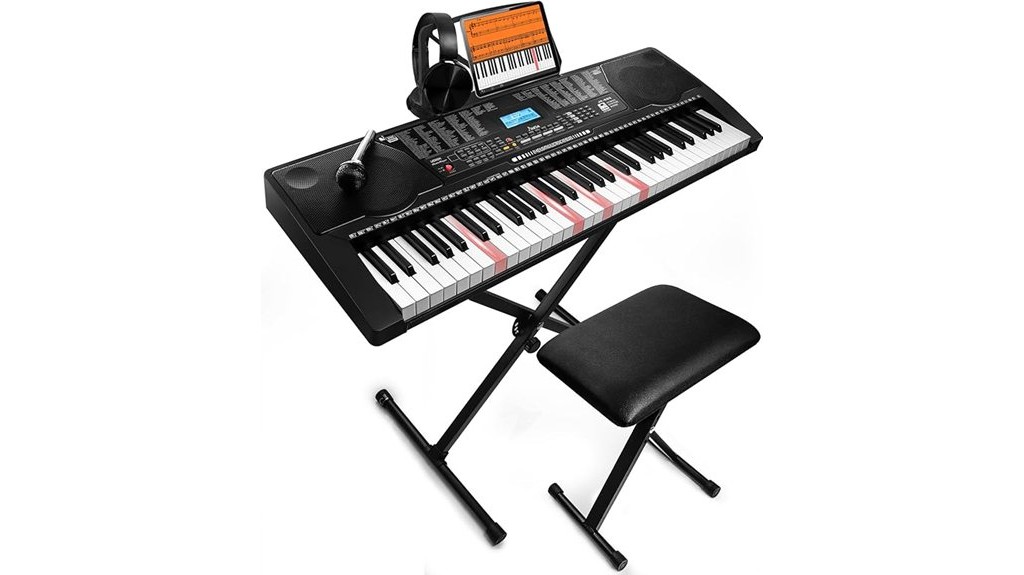
JIKADA-61 stands out as an excellent choice for adult beginners enthusiastic to immerse themselves in the world of music with ease. With its 61 lighted full-size keys, it guides you in finger placement, making learning intuitive. The keyboard’s three teaching modes cater to different learning styles, while the LCD display helps track your progress. Enjoy rich sound quality through built-in stereo speakers, and connect effortlessly using the 3.5mm jack or auxiliary ports. The super bundle includes essential accessories like an x-shaped stand, headphones, and more. Despite minor critiques on the music rest, it remains a top pick for new musicians.
Best For: Adult beginners who are eager to learn and explore music with intuitive guidance and supportive features.
Pros:
- Lighted full-size keys that guide finger placement for easy learning.
- Includes a comprehensive accessory bundle with an x-shaped stand and headphones.
- Offers a variety of teaching modes, sound options, and connectivity features for enhanced learning.
Cons:
- Lacks an instruction manual, which may pose a challenge for setup.
- Music rest stability is criticized by some users.
- May not fully satisfy the needs of advanced players seeking more complex features.
Alesis 88 Key Keyboard Piano for Beginners with Accessories
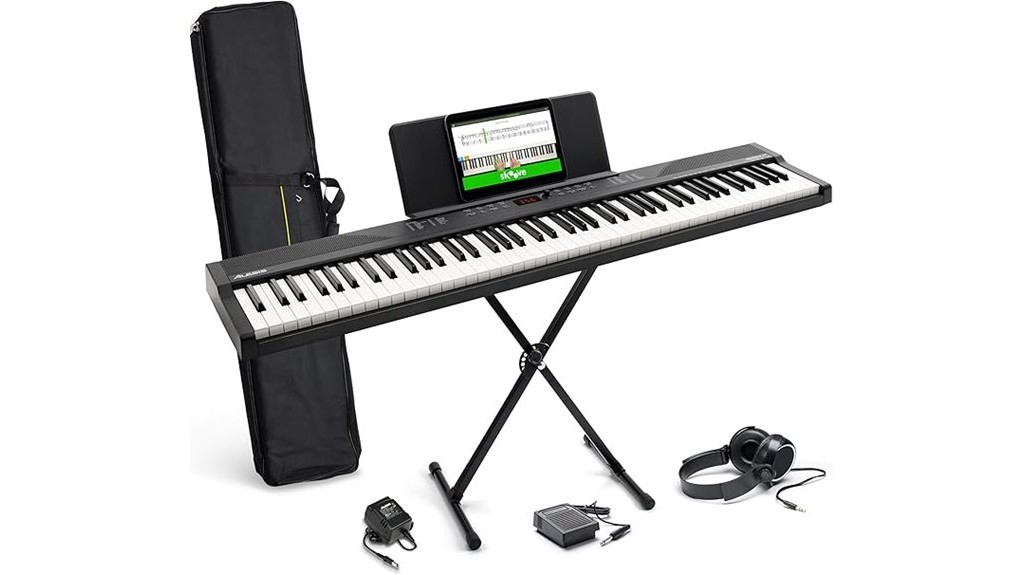
Looking for a beginner-friendly electronic piano in 2025? The Alesis 88 Key Keyboard Piano is perfect for you. It features 88 full-size, touch-sensitive keys and built-in speakers for an authentic experience. You’ll enjoy 480 realistic sounds, adjustable reverb, and one-touch song mode with 160 rhythms and 140 demo songs. Educational tools like Split, Lesson, and Record Modes enhance learning, supported by a built-in metronome and transpose function. Connect easily with USB-MIDI for recording or software use. The accessory bundle includes a stand, sustain pedal, headphones, and more. Plus, it’s portable with battery or adapter power options.
Best For: Beginners looking for a portable and versatile keyboard with a wide range of sounds and educational features.
Pros:
- 88 full-size, touch-sensitive keys for an authentic playing experience.
- Comprehensive sound library with 480 sounds, 160 rhythms, and 140 demo songs.
- Includes a full accessory bundle with stand, sustain pedal, headphones, and more.
Cons:
- Limited to beginners, may not satisfy advanced players.
- Built-in speakers may not provide high-quality sound for professional use.
- Battery operation can be limited by the lifespan of 6 AA batteries.
Yamaha P225B Digital Piano with Power Supply and Sustain Pedal (88-Key)
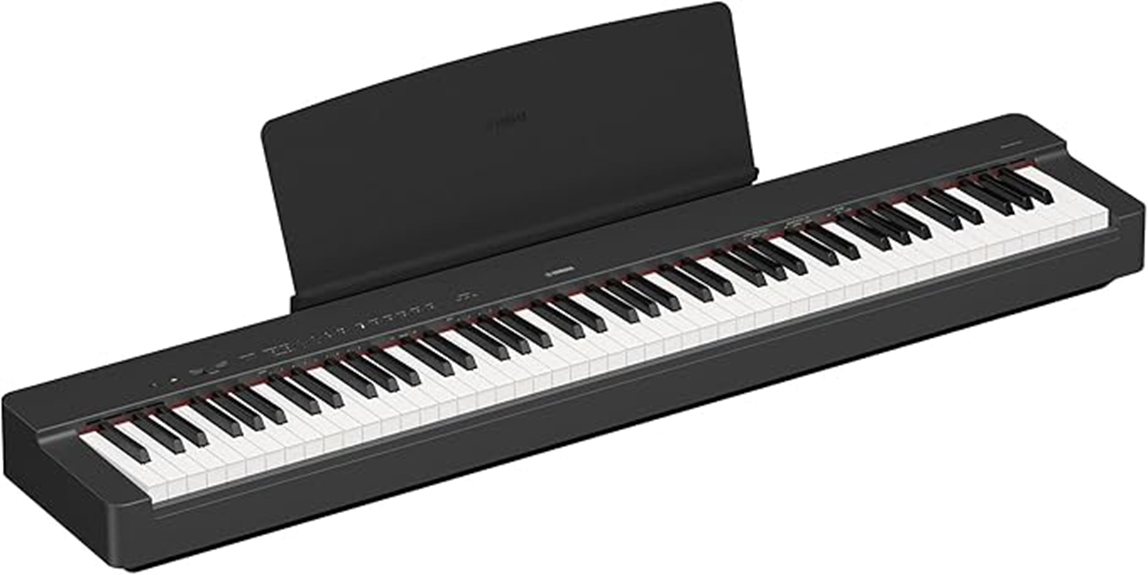
Experience the future of digital pianos with the Yamaha P225B, designed for pianists seeking authenticity and innovation. This 88-key digital piano offers Graded Hammer Compact keyboard action, delivering a genuine acoustic feel. Its compact design fits seamlessly in any space without compromising on quality. You’ll love the CFX Premium Grand Piano Voice, providing the rich, powerful sound of Yamaha’s flagship CFX concert grand. Virtual Resonance Modeling (VRM) adds real-time resonance, enhancing your playing experience. The half-damper pedal gives you nuanced control over sustain, while the Smart Pianist app lets you easily manage functions and access extra features.
Best For: Pianists looking for an authentic acoustic piano feel in a compact digital design with innovative features.
Pros:
- Graded Hammer Compact keyboard action provides a realistic acoustic piano experience.
- CFX Premium Grand Piano Voice delivers rich and powerful sound.
- Virtual Resonance Modeling enhances the authenticity of resonance.
Cons:
- May require additional accessories for advanced features.
- Limited to the features available through the Smart Pianist app.
- Compact design may not appeal to those seeking a traditional piano aesthetic.
Donner DDP-400 Digital Piano with 88 Key Progressive Weighted Keyboard
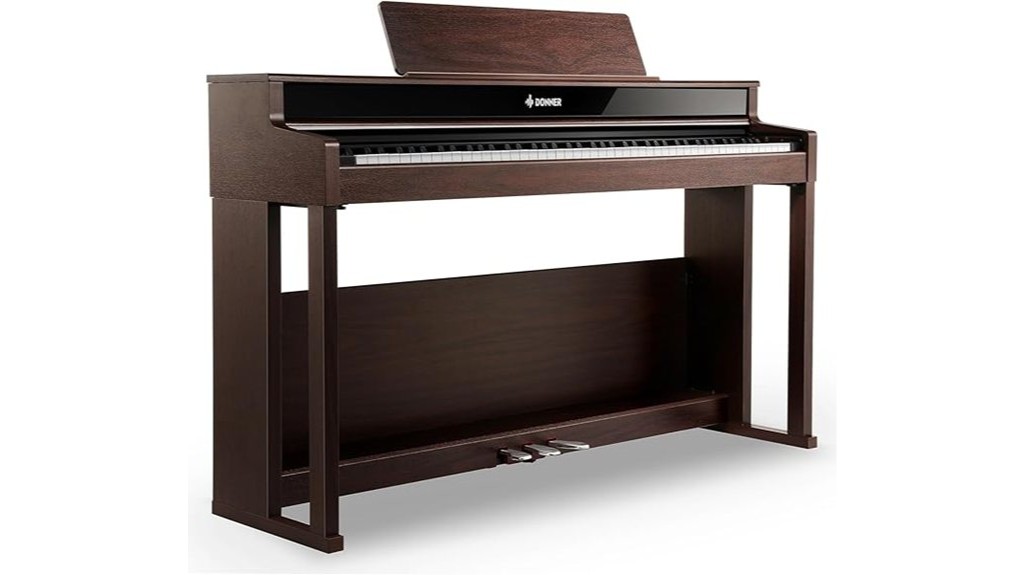
The Donner DDP-400 Digital Piano with its 88-key progressive weighted keyboard is perfect for pianists seeking an authentic piano feel without the bulk of an acoustic grand. You’ll appreciate the full-sized hammer-action keys with a double-contact design that captures finger strength changes, offering a realistic touch. Its upgraded French Dream sound, paired with 15W dual amps, delivers a rich acoustic piano experience. The extended speaker cabinet guarantees deeper resonance, while the vintage-inspired design fits any setting. With 128 polyphony, 138 tones, and USB MIDI connectivity, it’s ideal for app-based lessons. Plus, it’s compact, space-saving, and includes headphones for late-night practice.
Best For: Pianists seeking an authentic acoustic piano feel in a compact, space-saving digital format with modern connectivity features.
Pros:
- Realistic touch with 88-key full-sized hammer-action progressive weighted keyboard.
- Upgraded sound system with French Dream sound and 15W dual amps for rich acoustic experience.
- Compact design with vintage-inspired aesthetics suitable for various settings.
Cons:
- At 49.54 Kg, it may be heavy for frequent moving.
- Limited to 128 max polyphony which might not satisfy advanced pianists seeking more.
- Lack of advanced features like built-in recording or multiple pedal functions.
Factors to Consider When Choosing Electronic Pianos for 2025
As we look ahead to 2025, there are several key factors to keep in mind when selecting an electronic piano. We should consider the feel of the weighted keys, quality of sound options, and the available connectivity features. Additionally, let’s not overlook space, portability, and learning tools that can enhance our playing experience.
Weighted Key Feel
When choosing an electronic piano in 2025, the feel of weighted keys is an important factor to take into account for an authentic playing experience. Weighted keys mimic the acoustic piano feel through graded hammer action, offering heavier resistance in lower octaves and lighter in higher ones. This design is vital for developing proper finger strength and technique, making these pianos ideal for serious students and performers alike.
We should also consider touch sensitivity, which allows players to express dynamic control by adjusting their playing intensity. Advanced technologies, like double-contact sensors, further enhance key responsiveness, catering to both beginners and seasoned musicians. These features guarantee that the electronic pianos provide a realistic and satisfying playing experience, bridging the gap between digital and traditional pianos.
Sound Quality Options
Choosing the right electronic piano in 2025 involves more than just the feel of the keys; sound quality plays an essential role in the decision-making process. High-quality acoustic piano samples are vital for achieving a realistic sound experience, capturing the tonal richness of traditional pianos. With digital pianos offering multiple sound options, including instruments like organ and strings, we gain versatility for various musical styles. Audio fidelity’s clarity and precision greatly enhance playability, especially with headphones for private practice. Built-in speakers should offer good volume and sound quality for casual use, with options for external amplification. Advanced features like Virtual Resonance Modeling (VRM) further enhance sound realism, recreating the resonance of piano strings for a truly authentic experience.
Connectivity Features
Several connectivity features in electronic pianos of 2025 can greatly enhance our playing and learning experiences. With Bluetooth connectivity, we enjoy seamless pairing with devices for audio streaming and MIDI communication, enriching our practice sessions. USB-MIDI ports are essential for connecting to computers, allowing us to use music production software and educational apps, thereby broadening our learning and recording capabilities. Auxiliary inputs and outputs offer versatility by enabling connections to external audio devices, amplifiers, and recording equipment. Dual headphone jacks are perfect for two users to practice simultaneously without disturbing others, making them ideal for teaching scenarios. Finally, built-in audio recording and playback functions help us monitor progress and refine skills by reviewing our performances.
Space and Portability
Selecting the right electronic piano for 2025 involves considering its space and portability features. We should look at the dimensions and weight, as compact models fit well in limited spaces and are easier to transport. Lightweight designs, typically between 21 to 55 pounds, make moving these instruments a breeze. It’s crucial to find models that can run on batteries and a power adapter, allowing flexibility in various settings without relying on outlets. Additionally, whether a piano includes a built-in stand or requires a separate one affects space needs and setup simplicity. Opting for a sleek, minimalist design guarantees the piano integrates into home decor seamlessly while remaining easy to move or store when not in use.
Learning Tools Available
As technology advances, electronic pianos in 2025 offer an array of learning tools that cater to our diverse educational needs. Built-in teaching modes and lesson functions adapt to various learning styles, making them perfect for beginners. Lighted keys guide finger placement, helping us visually connect with notes. Advanced connectivity options, like USB-MIDI support, let us link to educational software and apps, opening up interactive learning and extensive resources. Record and playback functions capture our performances, allowing us to review and spot improvement areas. Additionally, virtual lessons with interactive feedback and tutorials have gained popularity, offering us the flexibility to learn at our pace with real-time guidance. These features make learning more intuitive and engaging for everyone.
Price and Value
While the learning tools available in 2025 electronic pianos make them incredibly appealing, understanding the price and value aspects is equally important for making a wise purchase. We should start by examining the price range, which can vary from $200 for entry-level models to over $1,000 for advanced ones. It’s essential to assess the value by considering features like weighted keys, sound quality, and connectivity options, which can justify a higher price. Don’t forget to factor in additional costs for accessories such as pedals and stands. Customer ratings, typically ranging from 4.0 to 4.7 stars, can offer insights into satisfaction levels. Plus, a robust warranty and support services can enhance value by ensuring long-term reliability.
Design and Aesthetics
When choosing an electronic piano in 2025, design and aesthetics play an essential role in how well it fits into our living spaces. We’ve got a range of styles to evaluate, from sleek Scandinavian minimalism to charming vintage-inspired pieces. Compact models with dimensions like 50.8D x 15W x 35.7H are perfect for tight spaces, while their elegant finishes offer seamless integration into our decor.
A piano that’s well-designed doesn’t just look good—it enhances our playing experience. Ergonomic layouts and high-quality materials like wood or alloy steel boost durability and visual appeal. Let’s not forget color options; classic black or white finishes allow us to personalize our instrument, ensuring it complements our home and personal style beautifully.
Conclusion
To sum up, we’ve explored the top electronic pianos of 2025, each offering unique features that cater to different musical needs. Whether you’re a beginner looking for essential learning tools or a seasoned musician seeking advanced connectivity and superior sound, there’s something for everyone. With options ranging from budget-friendly to professional-grade, these pianos promise an immersive playing experience. Let’s embrace innovation and elevate our musical journey with these exceptional instruments. Happy playing!



